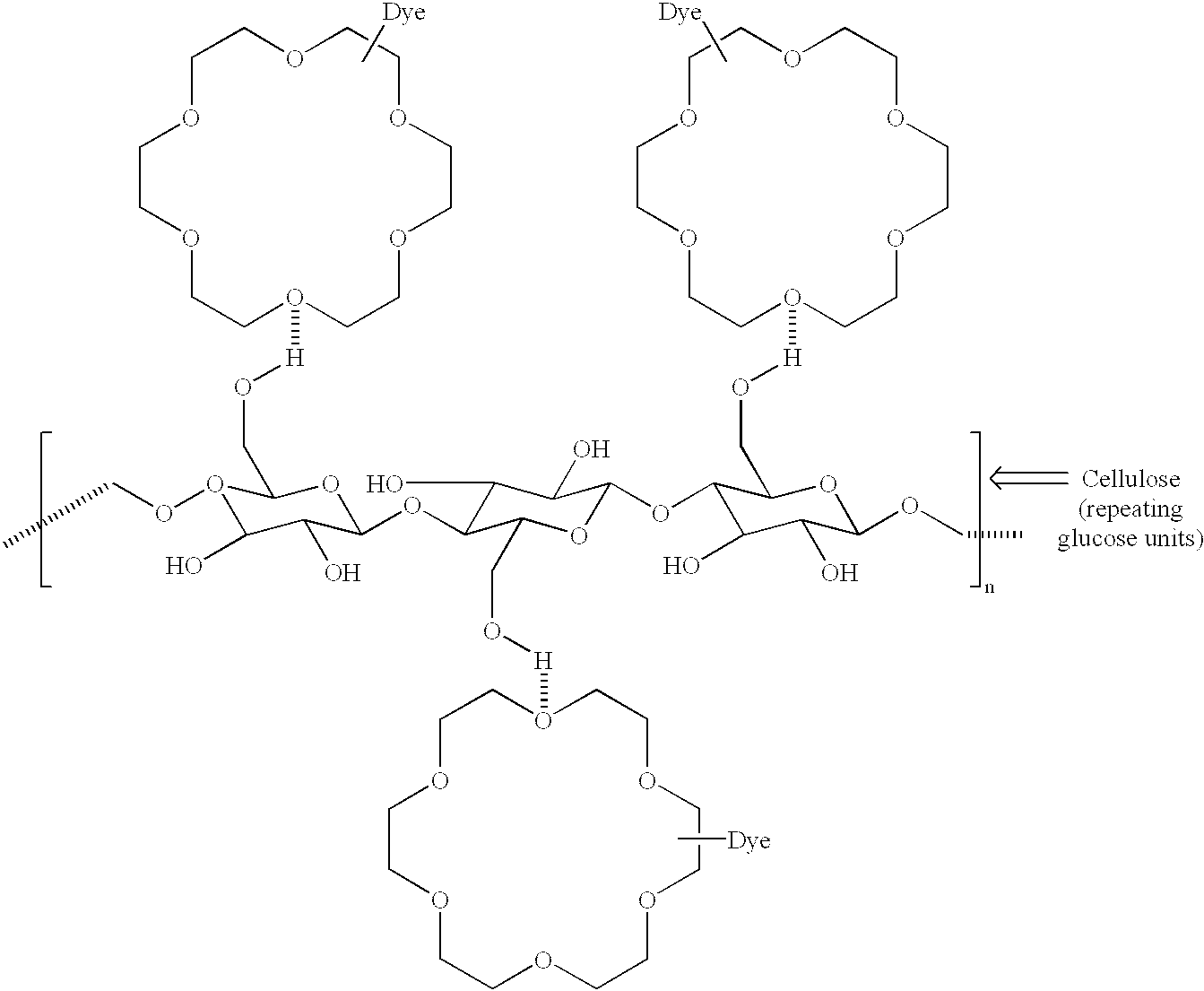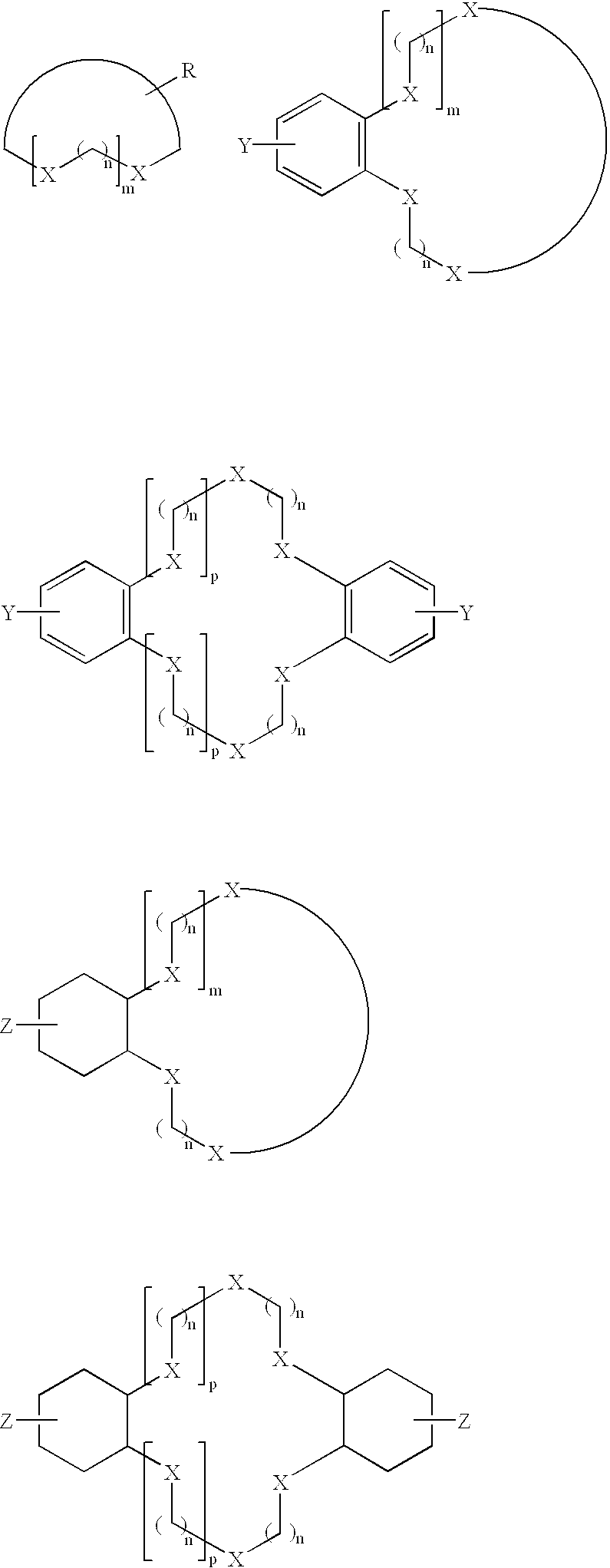Derivatization of dyes/pigments with crown ethers and inkjet printing fluids containing the same
a technology of dyes/pigments and inkjet printing fluids, which is applied in the field of inkjet ink, can solve the problems of reducing the chroma of printed materials, affecting the lightfastness of printed materials, and degrading the media on which the print is placed, and achieves the effect of greater durability
- Summary
- Abstract
- Description
- Claims
- Application Information
AI Technical Summary
Benefits of technology
Problems solved by technology
Method used
Image
Examples
example # 1
Example #1: Derivatization of Reactive Dye
The synthesis of crown ether derivatized dyes using triazinyl reactive dyes may be conducted by several methods as shown in Reaction Schemes 1-4. ##STR3## ##STR4## ##STR5## ##STR6##
The following exemplify the typical reaction conditions designated as (a), (b), (c), or (d) in Reaction Schemes 1-4:
Reaction (a): Dissolve dye / chromophore in water at neutral pH (pH.about.7) and add to an ice cold suspension of cyanuric chloride (ice bath made up from 1:1 acetone:ice water) at a dye / chromophore to cyanuric chloride molar ratio of about 1:1. Stir the reaction mixture for about 2 hours. The reaction product may then be isolated through precipitation methods, rinsing with hexanes and followed by drying the precipitate.
Reaction (b): Dissolve the dichlorotriazinyl compound in water at neutral pH (pH.about.7) and add a one molar equivalent of the reactive material which has been dissolved in water at pH.about.7. Raise the temperature to 35.degree. C. an...
example # 2
Example #2: Derivatization of Dye Containing Primary or Secondary Amine
A crown ether, containing a primary or secondary halogen (Br or I can be used in place of Cl, n=1-6 aliphatic chain, or may even consist of an aromatic substituent or other substituent to give other desired physical properties to the molecule), is reacted with a chromophore which has a primary or secondary amine group. This dye may then undergo the reactions as provided in Reaction Scheme 5. ##STR7##
Reaction (e): Dissolve one molar equivalent of the starting dye in a polar, aprotic solvent (acetonitrile, dimethylformamide, etc.) with one molar equivalent of the crown ether. Reflux the mixture while stirring vigorously overnight. At the end of this time, the dye may be purified through precipitation techniques and dried thoroughly by rinsing with hexanes.
An alternate pathway to derivatizing these types of dyes is given in the following schematic (using Reaction Scheme 6): ##STR8##
Reaction (f): Dissolve one molar e...
example # 3
Example #3: Friedel-Crafts Alkylation
In this example, a highly aromatic pigment and / or dye undergoes the Friedel-Crafts alkylation for multiple substitutions of crown ethers. If this reaction is to be controlled, a Friedel-Crafts acylation may take place in which the halogenated crown ether is replaced by a acylhalide substituted crown ether. Because of the electron withdrawing ability of the carbonyl group, the extent of substitution is much more reduced by using the acylhalides. Conditions for this reaction are given under Reaction Scheme 7. ##STR9##
Reaction (g): In a well-ventilated heating apparatus, place 2.0 g. of aluminum chloride (AlCl.sub.3) in about 50 mL of methylene chloride (CH.sub.2 Cl.sub.2) and begin stirring. Slowly add the halogenated crown ether to this solution. When an excess of halogenated crown ether has been used (use a 2.times. to 5.times.wt % to pigment ratio for the crown ether), slowly add a suspension of the pigment (suspended in methylene chloride) to t...
PUM
| Property | Measurement | Unit |
|---|---|---|
| temperature | aaaaa | aaaaa |
| temperature | aaaaa | aaaaa |
| wt % | aaaaa | aaaaa |
Abstract
Description
Claims
Application Information
 Login to View More
Login to View More - R&D
- Intellectual Property
- Life Sciences
- Materials
- Tech Scout
- Unparalleled Data Quality
- Higher Quality Content
- 60% Fewer Hallucinations
Browse by: Latest US Patents, China's latest patents, Technical Efficacy Thesaurus, Application Domain, Technology Topic, Popular Technical Reports.
© 2025 PatSnap. All rights reserved.Legal|Privacy policy|Modern Slavery Act Transparency Statement|Sitemap|About US| Contact US: help@patsnap.com



